In this series I will be lecturing on small units primarily in accordance with United States Army doctrine. We will begin by defining several terms in order to lay the groundwork for the lecture, and then over the course of several days we will discuss simple small unit tactics. Let's begin.
Movement:
Travelling: Small Units will use the traveling movement technique when contact with the enemy is not expected, and speed is necessary. While traveling 10 meters will be left between individual soldiers, and 20 meters will be left between squads.
Traveling Overwatch: Small units will use traveling overwatch when enemy contact is possible. While in traveling overwatch the lead squad stays between 50 and 100 meters in front of the rest of the platoon. Additionally the lead squad maintains 50 meters between teams, and 20 meters between soldiers. The remainder of the platoon uses the normal traveling technique. The purpose of this is so that the lead squad can detect and engage the enemy before the enemy observes the main unit. The distance between the lead squad and main element also allows the main element to maneuver and flank the enemy.
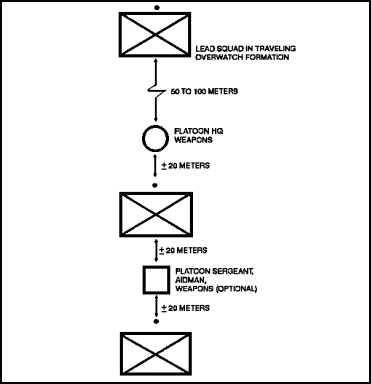 Bounding Overwatch: Small Units will use bounding overwatch when contact is likely or when crossing a known danger area. The Platoon will execute either successive or alternating bounds. Soldiers will attempt to leave 20 meters between themselves. Distance between squads will be determined by terrain and available cover and concealment.
Bounding Overwatch: Small Units will use bounding overwatch when contact is likely or when crossing a known danger area. The Platoon will execute either successive or alternating bounds. Soldiers will attempt to leave 20 meters between themselves. Distance between squads will be determined by terrain and available cover and concealment.
Successive Bounding: One element moves to a position, and then the overwatching element moves to a position on line with the first element.
Alternating Bounds: One element moves to a position, and then the overwatching element moves to a position in front of the first element.
 Platoon Formations:
Platoon Formations:
Platoon Column: One of the most common movement formations. In the Platoon column formation the Platoon Leader is situated behind the first squad and in front of the first Machine gun team. The Platoon Sergeant is situated behind the second squad and in front of the second machine gun team. In this way leadership and mass casualty producing weapons are distributed evenly throughout the formation. The individual squads are organized in wedges so that no two soldiers are on line. By doing this soldiers can shift fire to either side of the formation without risk of fratricide.
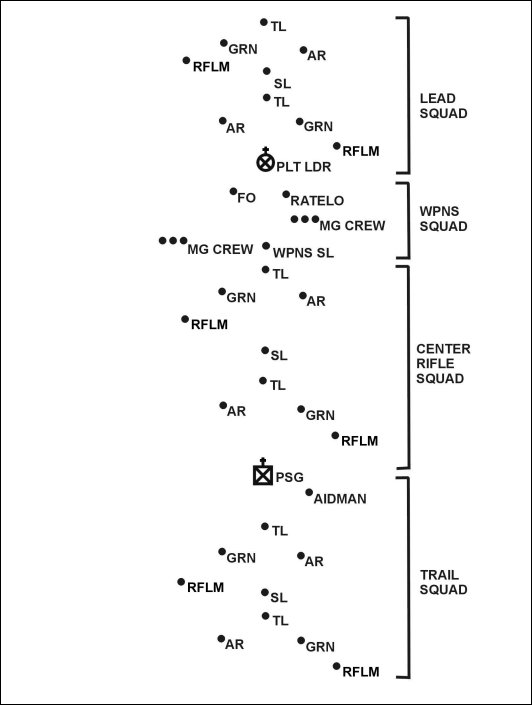 Platoon Vee: This formation allows a platoon to deliver a heavy, and sustained volume of fire upon making contact with the enemy. With two flank squads, the trial squad is able to either maneuver or provide overwatch.
Platoon Vee: This formation allows a platoon to deliver a heavy, and sustained volume of fire upon making contact with the enemy. With two flank squads, the trial squad is able to either maneuver or provide overwatch.
 Platoon Wedge: The Platoon wedge is the opposite of the Platoon Vee. The Platoon Wedge has two trail squads and a single lead element. This allows for ease of maneuver of the trail squads, and rapid transition into bounding overwatch.
Platoon Wedge: The Platoon wedge is the opposite of the Platoon Vee. The Platoon Wedge has two trail squads and a single lead element. This allows for ease of maneuver of the trail squads, and rapid transition into bounding overwatch.
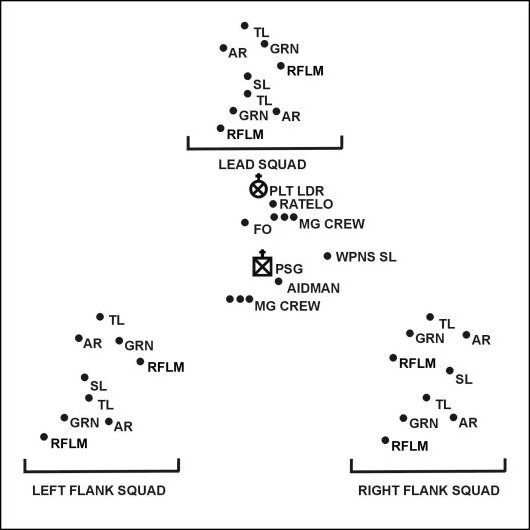 Platoon File: The Platoon File is used only in traveling when moving through difficult terrain, or when speed is necessary. Distance between soldiers is less than normal in order to allow the passing of messages up and down the file.
Platoon File: The Platoon File is used only in traveling when moving through difficult terrain, or when speed is necessary. Distance between soldiers is less than normal in order to allow the passing of messages up and down the file.
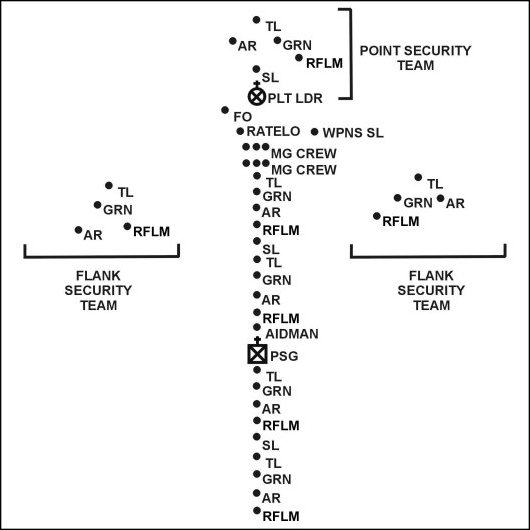
Small Unit Tactics: The application of Army Doctrine for the deployment of Platoon sized elements and below.
Fire-team: 3-5 soldiers led by a Sergeant.
Squad: 4-10 soldiers, typically consisting of two fire-teams led by a Staff Sergeant.
Platoon: 16-42 soldiers, typically consisting of four squads. The Platoon is led by a Sergeant First Class and a Second Lieutenant.
Platoon Sergeant: The Platoon Sergeant is the senior most non commissioned officer in the Platoon. It is his duty to advise the Platoon leader, lead the platoon in his absence, and maintain the welfare of the soldiers in the Platoon.
Platoon Leader: The Platoon leader is the only officer in the platoon. He is responsible for everything the platoon does, and does not accomplish. This includes tactical employment, training, admin, management, and logistics.
Fire-team: 3-5 soldiers led by a Sergeant.
Squad: 4-10 soldiers, typically consisting of two fire-teams led by a Staff Sergeant.
Platoon: 16-42 soldiers, typically consisting of four squads. The Platoon is led by a Sergeant First Class and a Second Lieutenant.
Platoon Sergeant: The Platoon Sergeant is the senior most non commissioned officer in the Platoon. It is his duty to advise the Platoon leader, lead the platoon in his absence, and maintain the welfare of the soldiers in the Platoon.
Platoon Leader: The Platoon leader is the only officer in the platoon. He is responsible for everything the platoon does, and does not accomplish. This includes tactical employment, training, admin, management, and logistics.
Movement:
Travelling: Small Units will use the traveling movement technique when contact with the enemy is not expected, and speed is necessary. While traveling 10 meters will be left between individual soldiers, and 20 meters will be left between squads.
Traveling Overwatch: Small units will use traveling overwatch when enemy contact is possible. While in traveling overwatch the lead squad stays between 50 and 100 meters in front of the rest of the platoon. Additionally the lead squad maintains 50 meters between teams, and 20 meters between soldiers. The remainder of the platoon uses the normal traveling technique. The purpose of this is so that the lead squad can detect and engage the enemy before the enemy observes the main unit. The distance between the lead squad and main element also allows the main element to maneuver and flank the enemy.

Successive Bounding: One element moves to a position, and then the overwatching element moves to a position on line with the first element.
Alternating Bounds: One element moves to a position, and then the overwatching element moves to a position in front of the first element.

PLT LDR=Platoon Leader
PLT SGT=Platoon Sergeant
RTO=Radio Telephone Operator
FO=Forward Artillery Observer
WPNS SL=Weapons Squad Leader
SL=Squad Leader
TL=Team Leader
RFLM=Rifleman
GRN=Grenadier
AR=Automatic Rifleman
MG Crew=Machine Gun Crew
PLT SGT=Platoon Sergeant
RTO=Radio Telephone Operator
FO=Forward Artillery Observer
WPNS SL=Weapons Squad Leader
SL=Squad Leader
TL=Team Leader
RFLM=Rifleman
GRN=Grenadier
AR=Automatic Rifleman
MG Crew=Machine Gun Crew
Platoon Column: One of the most common movement formations. In the Platoon column formation the Platoon Leader is situated behind the first squad and in front of the first Machine gun team. The Platoon Sergeant is situated behind the second squad and in front of the second machine gun team. In this way leadership and mass casualty producing weapons are distributed evenly throughout the formation. The individual squads are organized in wedges so that no two soldiers are on line. By doing this soldiers can shift fire to either side of the formation without risk of fratricide.








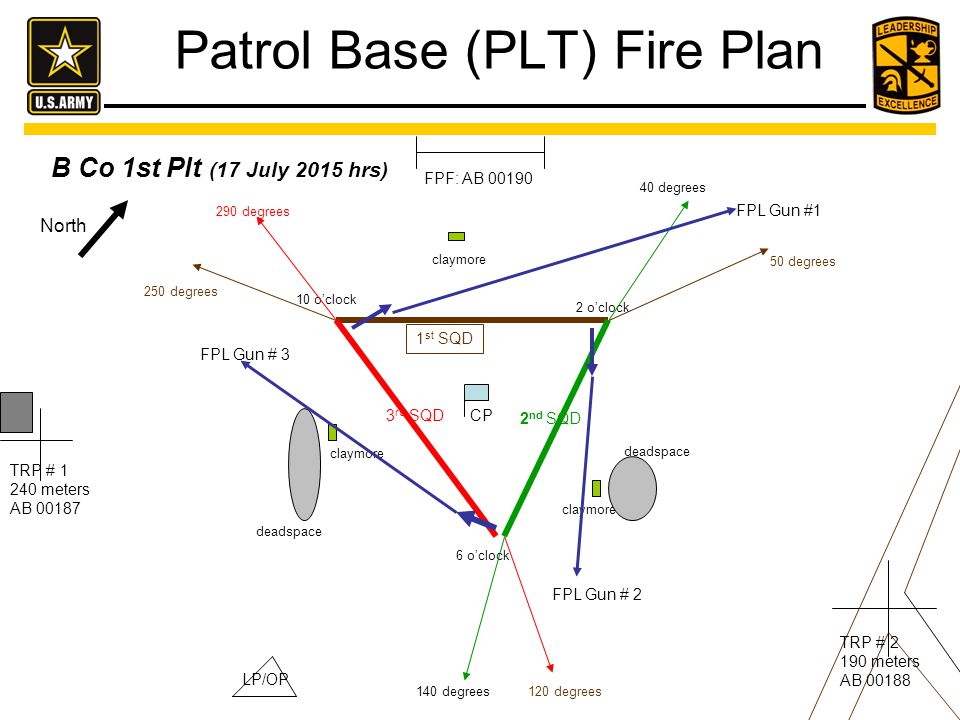
 I'll be continuing this at some point!
I'll be continuing this at some point!